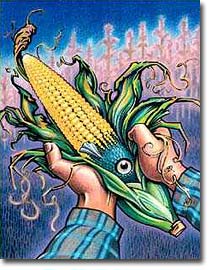GMO's:
This new technology within the food industry takes genes from other organisms and inserts them into the DNA of food crops or animals. This makes the crops or animals resistance to pesticides and some diseases. The genes come from bacteria, viruses, plants, and animals. This creates a new life form that would not have occurred in nature. This may sounds okay but..........
This new technology within the food industry takes genes from other organisms and inserts them into the DNA of food crops or animals. This makes the crops or animals resistance to pesticides and some diseases. The genes come from bacteria, viruses, plants, and animals. This creates a new life form that would not have occurred in nature. This may sounds okay but..........
Why GMO crops?
The majority of these crops have been genetically changed so the crop will not die when sprayed with pesticides and herbicides. However, studies have shown that farmers who grow GMO soybeans use 2-5 times more herbicides than farmers who grow natural soy varieties. Other studies have shown that GE crops can cross-pollinate with related weeds, resulting in "super weeds" that become difficult to control. Canadian canola growers have found weeds in their fields resistant to Round-Up and Liberty herbicides, forcing the growers to use more potent toxic herbicides.

In the works: GMO salmon. The FDA may soon approve a GMO salmon. A gene is inserted into the salmon to make it grow faster.
Legally, the products do not have to be labeled GMO. If they are so good for you why are they trying to hide it?
Most of us eat GMO foods without realizing it! Don't you want the right to control what your body ingests?
Why shouldn't we eat GMO foods?
Simple, we don't know the health consequences. These food have not been tested before they were put on our grocery shelves.
The GMO foods may cause new food allergies and antibiotic resistance.
Don't think that these corporations take your best interest to "heart". There are many things that "they" thought were okay and turned out to cause health risks, cancers, and even death (i.e. cigarettes, plastic, lead, asbestos, etc.).
How to avoid GMO foods:
1. Buy organic.
2. Shop at your local farmers market.
3. Download this list from True Food Network.
or download the app.








